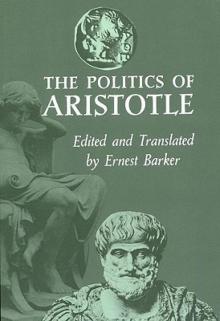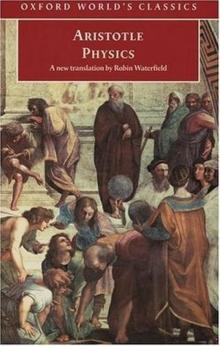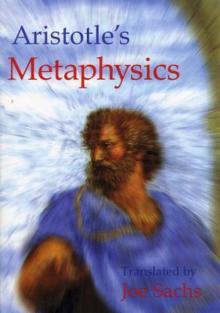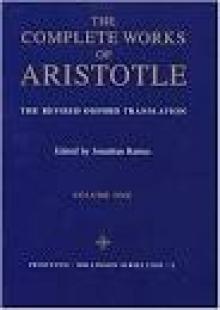Various Works Read online
Page 55
plant is to produce seed and fruit. But still as, in the case of
nutriment, animals with straight intestines are more violent in
their desire for food, so those which have not testes but only
ducts, or which have them indeed but internally, are all quicker in
accomplishing copulation. But those which are to be more temperate
in the one case have not straight intestines, and in the other have
their ducts twisted to prevent their desire being too violent and
hasty. It is for this that the testes are contrived; for they make the
movement of the spermatic secretion steadier, preserving the folding
back of the passages in the vivipara, as horses and the like, and in
man. (For details see the Enquiries about Animals.) For the testes
are no part of the ducts but are only attached to them, as women
fasten stones to the loom when weaving; if they are removed the
ducts are drawn up internally, so that castrated animals are unable to
generate; if they were not drawn up they would be able, and before now
a bull mounting immediately after castration has caused conception
in the cow because the ducts had not yet been drawn up. In birds and
oviparous quadrupeds the testes receive the spermatic secretion, so
that its expulsion is slower than in fishes. This is clear in the case
of birds, for their testes are much enlarged at the time of
copulation, and all those which pair at one season of the year have
them so small when this is past that they are almost indiscernible,
but during the season they are very large. When the testes are
internal the act of copulation is quicker than when they are external,
for even in the latter case the semen is not emitted before the testes
are drawn up.
5
Besides, quadrupeds have the organ of copulation, since it is
possible for them to have it, but for birds and the footless animals
it is not possible, because the former have their legs under the
middle of the abdomen and the latter have no legs at all; now the
penis depends from that region and is situated there. (Wherefore also
the legs are strained in intercourse, both the penis and the legs
being sinewy.) So that, since it is not possible for them to have
this organ, they must necessarily either have no testes also, or at
any rate not have them there, as those animals that have both penis
and testes have them in the same situation.
Further, with those animals at any rate that have external testes,
the semen is collected together before emission, and emission is due
to the penis being heated by its movement; it is not ready for
emission at immediate contact as in fishes.
All the vivipira have their testes in front, internally or
externally, except the hedgehog; he alone has them near the loin. This
is for the same reason as with birds, because their union must be
quick, for the hedgehog does not, like the other quadrupeds, mount
upon the back of the female, but they conjugate standing upright
because of their spines.
So much for the reasons why those animals have testes which have
them, and why they are sometimes external and sometimes internal.
6
All those animals which have no testes are deficient in this part,
as has been said, not because it is better to be so but simply because
of necessity, and secondly because it is necessary that their
copulation should be speedy. Such is the nature of fish and
serpents. Fish copulate throwing themselves alongside of the females
and separating again quickly. For as men and all such creatures must
hold their breath before emitting the semen, so fish at such times
must cease taking in the sea-water, and then they perish easily.
Therefore they must not mature the semen during copulation, as
viviparous land-animals do, but they have it all matured together
before the time, so as not to be maturing it while in contact but to
emit it ready matured. So they have no testes, and the ducts are
straight and simple. There is a small part similar to this connected
with the testes in the system of quadrupeds, for part of the reflected
duct is sanguineous and part is not; the fluid is already semen when
it is received by and passes through this latter part, so that once it
has arrived there it is soon emitted in these quadrupeds also. Now
in fishes the whole passage resembles the last section of the
reflected part of the duct in man and similar animals.
7
Serpents copulate twining round one another, and, as said above,
have neither testes nor penis, the latter because they have no legs,
the former because of their length, but they have ducts like for on
account of their extreme length the seminal fluid would take too
long in its passage and be cooled if it were further delayed by
testes. (This happens also if the penis is large; such men are less
fertile than when it is smaller because the semen, if cold, is not
generative, and that which is carried too far is cooled.) So much for
the reason why some animals have testes and others not. Serpents
intertwine because of their inaptitude to cast themselves alongside of
one another. For they are too long to unite closely with so small a
part and have no organs of attachment, so they make use of the
suppleness of their bodies, intertwining. Wherefore also they seem
to be slower in copulation than fish, not only on account of the
length of the ducts but also of this elaborate arrangement in uniting.
8
It is not easy to state the facts about the uterus in female
animals, for there are many points of difference. The vivipara are not
alike in this part; women and all the vivipara with feet have the
uterus low down by the pudendum, but the cartilaginous viviparous fish
have it higher up near the hypozoma. In the ovipara, again, it is
low in fish (as in women and the viviparous quadrupeds), high in
birds and all oviparous quadrupeds. Yet even these differences are
on a principle. To begin with the ovipara, they differ in the manner
of laying their eggs, for some produce them imperfect, as fishes whose
eggs increase and are finally developed outside of them. The reason is
that they produce many young, and this is their function as it is with
plants. If then they perfected the egg in themselves they must needs
be few in number, but as it is, they have so many that each uterus
seems to be an egg, at any rate in the small fishes. For these are the
most productive, just as with the other animals and plants whose
nature is analogous to theirs, for the increase of size turns with
them to seed.
But the eggs of birds and the quadrupedal ovipara are perfect when
produced. In order that these may be preserved they must have a hard
covering (for their envelope is soft so long as they are increasing
in size), and the shell is made by heat squeezing out the moisture
for the earthy material; consequently the place must be hot in which
this is to happen. But the part about the hypozoma is hot, as is shown
by that being the part which concocts the food. If then
the eggs
must be within the uterus, then the uterus must be near the hypozoma
in those creatures which produce their eggs in a perfect form.
Similarly it must be low down in those which produce them imperfect,
for it is profitable that it should be so. And it is more natural
for the uterus to be low down than high up, when Nature has no other
business in hand to hinder it; for its end is low down, and where is
the end, there is the function, and the uterus itself is naturally
where the function is.
9
We find differences in the vivipara also as compared with one
another. Some produce their young alive, not only externally, but also
internally, as men, horses, dogs, and all those which have hair, and
among aquatic animals, dolphins, whales, and such cetacea.
10
But the cartilaginous fish and the vipers produce their young
alive externally, but first produce eggs internally. The egg is
perfect, for so only can an animal be generated from an egg, and
nothing comes from an imperfect one. It is because they are of a
cold nature, not hot as some assert, that they do not lay their eggs
externally.
11
At least they certainly produce their eggs in a soft envelope, the
reason being that they have but little heat and so their nature does
not complete the process of drying the egg-shell. Because, then,
they are cold they produce soft-shelled eggs, and because the eggs are
soft they do not produce them externally; for that would have caused
their destruction.
The process is for the most part the same as in birds, for the egg
descends and the young is hatched from it near the vagina, where the
young is produced in those animals which are viviparous from the
beginning. Therefore in such animals the uterus is dissimilar to
that of both the vivipara and ovipara, because they participate in
both classes; for it is at once near the hypozoma and also
stretching along downwards in all the cartilaginous fishes. But the
facts about this and the other kinds of uterus must be gathered from
inspection of the drawings of dissections and from the Enquiries.
Thus, because they are oviparous, laying perfect eggs, they have the
uterus placed high, but, as being viviparous, low, participating in
both classes.
Animals that are viviparous from the beginning all have it low,
Nature here having no other business to interfere with her, and
their production having no double character. Besides this, it is
impossible for animals to be produced alive near the hypozoma, for the
foetus must needs be heavy and move, and that region in the mother
is vital and would not be able to bear the weight and the movement.
Thirdly, parturition would be difficult because of the length of the
passage to be traversed; even as it is there is difficulty with
women if they draw up the uterus in parturition by yawning or anything
of the kind, and even when empty it causes a feeling of suffocation if
moved upwards. For if a uterus is to hold a living animal it must be
stronger than in ovipara, and therefore in all the vivipara it is
fleshy, whereas when the uterus is near the hypozoma it is membranous.
And this is clear also in the case of the animals which produce
young by the mixed method, for their eggs are high up and sideways,
but the living young are produced in the lower part of the uterus.
So much for the reason why differences are found in the uterus of
various animals, and generally why it is low in some and high in
others near the hypozoma.
12
Why is the uterus always internal, but the testes sometimes
internal, sometimes external? The reason for the uterus always being
internal is that in this is contained the egg or foetus, which needs
guarding, shelter, and maturation by concoction, while the outer
surface of the body is easily injured and cold. The testes vary in
position because they also need shelter and a covering to preserve
them and to mature the semen; for it would be impossible for them,
if chilled and stiffened, to be drawn up and discharge it.
Therefore, whenever the testes are visible, they have a cuticular
covering known as the scrotum. If the nature of the skin is opposed to
this, being too hard to be adapted for enclosing them or for being
soft like a true 'skin', as with the scaly integument of fish and
reptiles, then the testes must needs be internal. Therefore they are
so in dolphins and all the cetacea which have them, and in the
oviparous quadrupeds among the scaly animals. The skin of birds also
is hard so that it will not conform to the size of anything and
enclose it neatly. (This is another reason with all these animals for
their testes being internal besides those previously mentioned as
arising necessarily from the details of copulation.) For the same
reason they are internal in the elephant and hedgehog, for the skin of
these, too, is not well suited to keep the protective part separate.
[The position of the uterus differs in animals viviparous within
themselves and those externally oviparous, and in the latter class
again it differs in those which have the uterus low and those which
have it near the hypozoma, as in fishes compared with birds and
oviparous quadrupeds. And it is different again in those which produce
young in both ways, being oviparous internally and viviparous
externally. For those which are viviparous both internally and
externally have the uterus placed on the abdomen, as men, cattle,
dogs, and the like, since it is expedient for the safety and growth of
the foetus that no weight should be upon the uterus.]
13
The passages also are different through which the solid and liquid
excreta pass out in all the vivipara. Wherefore both males and females
in this class all have a part whereby the urine is voided, and this
serves also for the issue of the semen in males, of the offspring in
females. This passage is situated above and in front of the passage of
the solid excreta. The passage is the same as that of the solid
nutriment in all those animals that have no penis, in all the ovipara,
even those of them that have a bladder, as the tortoises. For it is
for the sake of generation, not for the evacuation of the urine,
that the passages are double; but because the semen is naturally
liquid, the liquid excretion also shares the same passage. This is
clear from the fact that all animals produce semen, but all do not
void liquid excrement. Now the spermatic passages of the male must
be fixed and must not wander, and the same applies to the uterus of
the female, and this fixing must take place at either the front or the
back of the body. To take the uterus first, it is in the front of
the body in vivipara because of the foetus, but at the loin and the
back in ovipara. All animals which are internally oviparous and
externally viviparous are in an intermediate condition because they
participate in both classes, being at once oviparous and viviparous.
For the u
pper part of the uterus, where the eggs are produced, is
under the hypozoma by the loin and the back, but as it advances is low
at the abdomen; for it is in that part that the animal is
viviparous. In these also the passage for solid excrement and for
copulation is the same, for none of these, as has been said already,
has a separate pudendum.
The same applies to the passages in the male, whether they have
testes or no, as to the uterus of the ovipara. For in all of them, not
only in the ovipara, the ducts adhere to the back and the region of
the spine. For they must not wander but be settled, and that is the
character of the region of the back, which gives continuity and
stability. Now in those which have internal testes, the ducts are
fixed from the first, and they are fixed in like manner if the
testes are external; then they meet together towards the region of the
penis.
The like applies to the ducts in the dolphins, but they have their
testes hidden under the abdominal cavity.
We have now discussed the situation of the parts contributing to
generation, and the causes thereof.
14
The bloodless animals do not agree either with the sanguinea or with
each other in the fashion of the parts contributing to generation.
There are four classes still left to deal with, first the crustacea,
secondly the cephalopoda, thirdly the insects, and fourthly the
testacea. We cannot be certain about all of them, but that most of
them copulate is plain; in what manner they unite must be stated
later.
The crustacea copulate like the retromingent quadrupeds, fitting
their tails to one another, the one supine and the other prone. For
the flaps attached to the sides of the tail being long prevent them
from uniting with the belly against the back. The males have fine
spermatic ducts, the females a membranous uterus alongside the
intestine, cloven on each side, in which the egg is produced.

 On Sophistical Refutations
On Sophistical Refutations The Categories
The Categories The Politics of Aristotle
The Politics of Aristotle Nicomachean Ethics
Nicomachean Ethics The Rhetoric & the Poetics of Aristotle
The Rhetoric & the Poetics of Aristotle POSTERIOR ANALYTICS
POSTERIOR ANALYTICS Physics
Physics Metaphysics
Metaphysics Various Works
Various Works